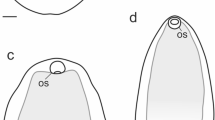Abstract
The literature associated with descriptions and definitions of the sucker-like attachment organs in trypanorhynchs, termed either bothria or bothridia, is reviewed. There are descriptions of 14 trypanorhynch species representing 10 families. In none of these trypanorhynchs was a membrane separating the attachment organ from the scolex parenchyma described, one of the definitions used to distinguish bothria from bothridia. Transmission electron microscopy of the bothria of the trypanorhynch species Nybelinia queenslandensis Beveridge & Jones, 1998 (Tentaculariidae) and Otobothrium mugilis Hiscock, 1954 (Otobothriidae) also failed to show any membranous structure separating the surface of the attachment organ from the cestode parenchyma. The sucker-like attachment organs of trypanorhynchan cestodes appear, therefore, to be bothria rather than bothridia. As a result, changes in the terminology of related features of the scolex are proposed here. Henceforth, the pars bothridialis should be referred to as the pars bothrialis and the bothridial pits should be referred to bothrial pits.
Similar content being viewed by others
References
Beveridge, I. & Campbell, R.A. (2003) Review of the Rhopa-lothylacidae Guiart, 1935 (Cestoda: Trypanorhyncha), with a description of the adult of Pintneriella musculicolaYamaguti, 1934 and a redescription of P. gymnorhynchoides(Guiart, 1935) comb. n. Folia Parasitologica, 50, 61–71.
Beveridge, I., Campbell, R.A. & Palm, H. (1999) Preliminary cladistic analysis of genera of the cestode order Trypanorhyncha Diesing, 1863. Systematic Parasitology, 42, 29–49.
Campbell, R.A. & Beveridge, I (1994) Order Trypanorhyncha. In: Khalil, L.F., Jones, A. & Bray, R.A. (Eds) Keys to the cest-ode parasites of vertebrates. Wallingford: CAB International, pp. 51–148.
Caira, J.N., Jensen, K & Healy, C.J. (1999) On the phylogen-etic relationships among tetraphyllidean, lecanicephalidean and diphyllidean tapeworm genera. Systematic Parasitology, 42, 77–151.
Conn, D.B. (1993) The biology of flatworms (Platyhelminthes)-parenchyma cells and extracellular matrices. Transactions of the American Microscopical Society, 112, 241–261.
Dollfus, R.-P. (1942) EtuFr des critiques sur les tétrarhynques du Muséum de Paris. Archives du Muséum National d'Histoire Naturelle, 19, 1–466.
Dollfus, R.-P. (1946) Notes diverses sur des Tétrarhynques. Mém-oires du Muséum National d'Histoire Naturelle, 22, 179–220.
Faliex, E., Tyler, G. & Euzet, L. (2001) A new species of Ditrachy-bothridium(Cestoda: Diphyllidea) from Galeussp. (Selachii, Scyliorhynidae) from the south Pacific Ocean, with a revision of the diagnosis of the order, family, and genus and notes on descriptive terminology of microtriches. Journal of Parasitology, 86, 1078–1084.
Fuhrmann, O. (1931) Dritte Klasse der Cladus Plathelminthes. Cest-oidea. In:Kükenthal, W & Krumbach, T. (Eds) Handbuch der Zoologie(1928-1933). Berlin: Walter de Gruyter & Co., pp. 141–416.
Hyman, L.H. (1951) The invertebrates: Platyhelminthes and Rhyncocoela. The acoelomate Bilateria.New York: McGraw-Hill, Vol. II, 550 pp.
Jensen, K. (2001) Four new genera and five new species of lecani-cephalideans (Cestoda: Lecanicephalidea) from elasmobranchs in the Gulf of California, Mexico. Journal of Parasitology, 87, 845–861.
Jones, M.K. (2000) Ultrastructure of the scolex, rhyncheal system and bothridial pits of Otobothrium mugilis(Cestoda: Trypanor-hyncha). Folia Parasitologica, 47, 29–38.
Jones, M.K. & Beveridge, I. (1998) Nybelinia queenslandensissp. n. (Cestoda: Trypanorhyncha) parasitic in Carcharhinus melan-opterus, from Australia, with observations on the fine structure of the scolex including the rhyncheal system. Folia Parasitologica, 45, 295–311.
Johnstone, J. (1912). Tetrarhynchus erinaceusvan Beneden. I. Structure of larva and adult worm. Parasitology, 4, 364–415.
Joyeux, C. & Baer, J.G. (1961) Classe des Cestodes. In: Grassé, P.-P. ( Ed. ) Traité de zoologie. Anatomie, systématique, biologie.Tome IV. Plathelminthes, Mésozoires, Acanthocéphales, Némer-tiens. Paris: Masson et Cie, pp. 347–560.
Mackenzie, K. (1965) The plerocercoid of Gilquinia squaliFabri-cius, 1794. Parasitology, 55, 607–615.
Nybelin, O. (1918) Zur Anatomie und systematischen Stellung von "Tetrabothrium" norvegicumOlsson. Göteborgs Kungliga Vetenskaps-och Vitterhets-Samhälles Handlingar, 20, 1–25.
Palm, H.W. (1997) An alternative classification of trypanorhynch cestodes considering the tentacular armature as being of limited importance. Systematic Parasitology, 37, 81–92.
Pintner, T. (1880) Untersuchungen über den Bau des Bandwurm-körpers mit besonderer Berücksichtigung der Tetrabothrien und Tetrarhynchen. Arbeiten aus dem Zoologischen Intitut der Uni-versität Wien,3, 163–242.
Pintner, T. (1930) Tetrarhynchen von den Forschungreisen des Dr. Sixten Bock. Göteborgs Kungliga Vetenskaps-och Vitterhets-Samhälles Handlingar, Femte Följden,Ser.B,8, 1–48.
Pintner, T. (1931) Wenigbekanntes und Unbekanntes von Rüssel-bandwürmern. II. Österreichische Akademie der Wissenschaften Sitzunzberichte, Mathematik Naturwissenschaftliche Klasse, Ab-teilung1, 140, 777–820.
Pintner, T. (1934) Bruckstücke zur Kenntnis der Rüsselbandwürmer. Zoologische Jahrbücher. Abteilung für Anatomie und Ontogenie der Tiere, 58, 1–20.
Rees, G. (1941a) The musculature and nervous systems of the plero-cercoid larva of Dibothriorhynchus grossus(Rud.) Parasitology, 33, 373–389.
Rees, G. (1941b) The scolex of Aporhynchus norvegicus (Olss.). Parasitology, 33, 433–438.
Rees, G. (1944) A new cestode of the genus Grillotiafrom a shark. Parasitology, 35, 180–185.
Rees, G. (1950) The plerocercoid larva of Grillotia heptanchi(Vaullegeard). Parasitology, 40, 265–272.
Rees, F.G. (1988) The muscle, nervous and excretory systems of the plerocercoid of Callitetrarhynchus gracilis(Rud., 1819) Pintner, 1931 (Cestoda: Trypanorhyncha) from Bermuda fishes. Parasitology, 96, 337–351.
Wardle, R.A. & McLeod, J.A. (1952) The zoology of tapeworms. New York: Hafner Publishing Co., 780 pp.
Author information
Authors and Affiliations
Rights and permissions
About this article
Cite this article
Jones, M.K., Beveridge, I., Campbell, R.A. et al. Terminology of the sucker-like organs of the scolex of trypanorhynch cestodes. Syst Parasitol 59, 121–126 (2004). https://doi.org/10.1023/B:SYPA.0000044428.55413.8a
Issue Date:
DOI: https://doi.org/10.1023/B:SYPA.0000044428.55413.8a




